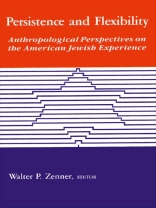Using a variety of anthropological approaches, the authors illustrate how the Jewish identity has persisted in the United States despite great subcultural variation and a wide range of adaptations. Within the various essays, attention is given to both mainstream Jews and to the Hasidim, Yemenites, Indian Sephardim, Soviet Emigres, and ‘Jews for Jesus.’ Institutions such as the family, the school, and the synagogue, are considered through techniques of participation/ observation and in archeological research. Persistence and Flexibility provides a means of viewing the Jewish community through the prism of key events, or rituals, and symbols.
Jadual kandungan
Preface
Introduction
1.
The Cultural Anthropology of American Jewry
Walter P. Zenner and Janet S. Belcove-Shalin
Part I. IDENTITIES AND IDENTIFICATION
2.
Stigma, Identity, and Sephardic-Ashkenazic Relations in Indianapolis
Jack Glazier
3.
American Yemenite Jewish Interethnic Strategies
Dina Dahbany-Miraglia
4.
Jewish in the USSR, Russian in the USA
Fran Markowitz
5.
Learning to Be a Part-Time Jew
David Schoem
6.
Integration into the Group and Sacred Uniqueness: Analysis of an Adult Bat Mitzvah
Stuart Schoenfeld
Part II. ARENAS OF JEWISH LIFE
7.
A Home Away from Home: Participation in Jewish Immigrant Associations in America
Hannah Kliger
8.
Family, Kinship, and Ethnicity: Strategies for Social Mobility
Myrna Silverman
9.
The Hasidim of North America: A Review of the Literature
Janet S. Belcove-Shalin
10.
Separatist Orthodoxy’s Attitudes Toward Community: The Breuer Community in Germany and America
Steven Lowenstein
11.
That Is the Pillar of Rachel’s Grave Unto This Day: An Ethnoarchaeological Comparison of Two Jewish Cemeteries in Lincoln, Nebraska
David Mayer Gradwohl and Hanna Rosenberg Gradwohl
12.
Jews and Judaica: Who Owns and Buys What?
Samuel Heilman
Glossary
Contributors
Index
Mengenai Pengarang
Walter P. Zenner is Professor of Anthropology at the State University of New York at Albany. He is the author of Persistence and Flexibility: Anthropological Perspectives on the American Jewish Experience, also published by SUNY Press












